Sandridge gidgee facts for kids
Quick facts for kids Sandridge gidgee |
|
|---|---|
| Scientific classification | |
| Genus: |
Acacia
|
| Species: |
anastema
|
 |
|
The Acacia anastema, often called sandridge gidgee or just gidgee, is a type of tree. It belongs to the plant family called Fabaceae, which includes peas and beans. This tree is special because it only grows in Western Australia. You can find it in a small, dry area east of Carnarvon.
Contents
What is Sandridge Gidgee?
The sandridge gidgee is an upright tree. It can grow up to seven metres tall. Like most Acacia trees, it does not have true leaves. Instead, it has special flattened stems called phyllodes. These phyllodes look and act like leaves.
How Does it Look?
The phyllodes of the sandridge gidgee can be quite long. They can grow up to twenty centimetres long. They can also be as wide as five centimetres.
The flowers of this tree are yellow. They grow in long, round clusters. These clusters are usually between two and four centimetres long. After the flowers, the tree produces pods. These pods are slightly curved. They can be up to 14 centimetres long and two to three centimetres wide.
Where Does Sandridge Gidgee Grow?
This unique tree is found only in Western Australia. It prefers semi-arid land. This means the area is quite dry, but not a complete desert. It grows in a specific region east of Carnarvon.
How is Sandridge Gidgee Used?
The sandridge gidgee has a few uses for people. Its long, straight branches are very strong. They are also resistant to termites. Termites are small insects that can damage wood. Because of this, the wood is often used locally for fence posts.
The tree's canopy, or top branches, are usually too high for animals to reach. This means that animals like livestock cannot eat its leaves or branches. So, it does not provide food for them.
See also
 In Spanish: Acacia anastema para niños
In Spanish: Acacia anastema para niños

